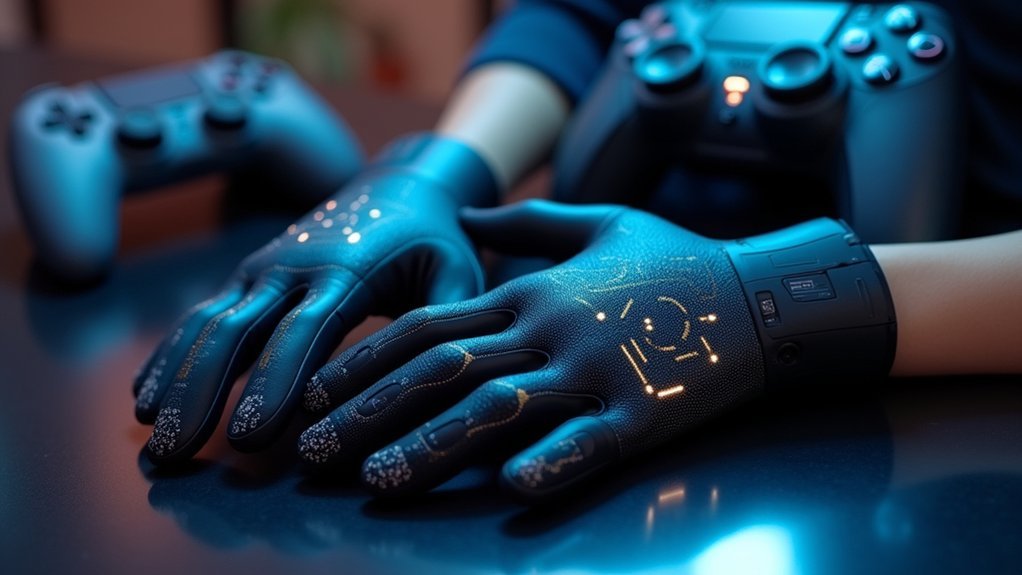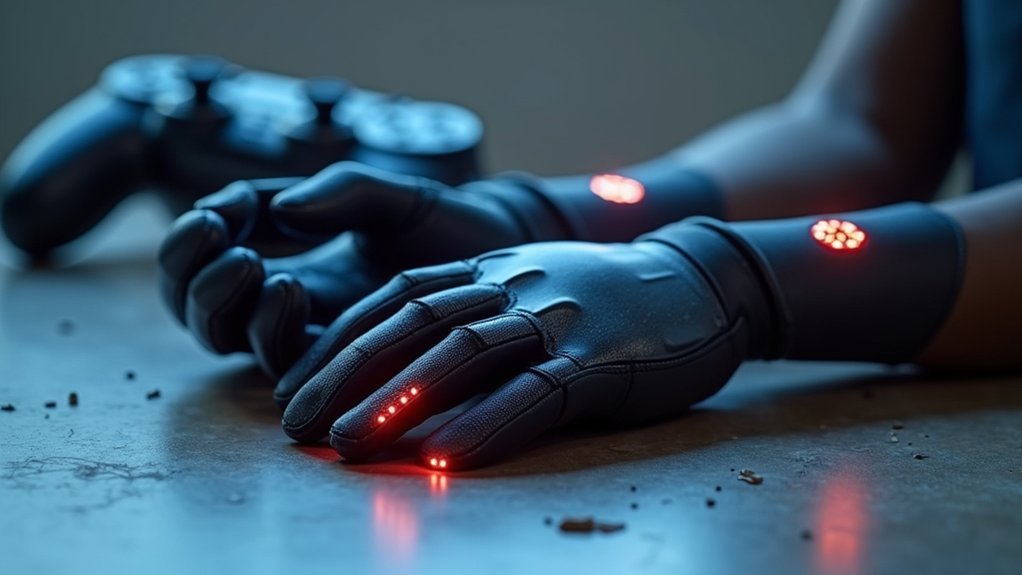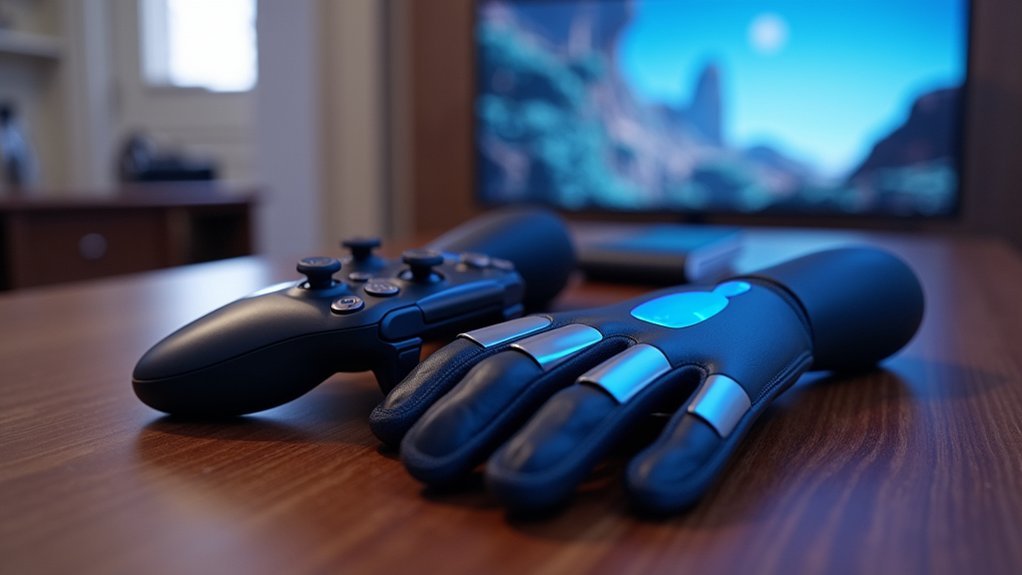VR haptic gloves beat traditional controllers because they let you interact with virtual objects using natural hand movements instead of memorizing complex button combinations. You’ll feel realistic textures, weight, and resistance when touching virtual surfaces like metal or wood, creating deeper immersion than pointing and clicking with handheld devices. They eliminate the visual distraction of looking down at controllers and reduce learning curves through intuitive muscle memory development. Continue exploring to discover how this technology revolutionizes training applications.
What Are VR Haptic Gloves and How Do They Work?

Revolution in virtual reality interaction begins when you slip on a pair of haptic gloves that transform how you experience digital worlds.
VR haptic gloves are sophisticated wearable devices that provide tactile feedback, enabling you to touch, grab, and manipulate virtual objects with remarkable realism in any VR environment.
Revolutionary wearable technology that delivers authentic tactile sensations, transforming virtual reality into a genuinely immersive hands-on experience.
This haptic glove technology operates through kinesthetic and tactile sensations that simulate authentic surface properties.
You’ll feel the difference between metal, plastic, and wood textures as you interact with virtual objects.
Advanced models like WEART’s TouchDIVER deliver multimodal feedback, including temperature variations that enhance immersion far beyond traditional controllers.
These gloves integrate seamlessly with multiple XR headsets, requiring no hardware modifications to your existing setup while delivering unprecedented interactive experiences.
The Limitations of Traditional VR Controllers
You’ve likely experienced the frustration of fumbling for the right button on your VR controller while trying to maintain immersion in a virtual world.
Traditional controllers restrict your interactions to predetermined button presses and joystick movements, preventing you from naturally grasping, touching, or manipulating objects as you’d in real life.
This disconnect between your physical movements and virtual actions greatly reduces the sense of presence that makes VR truly compelling.
Button Confusion Issues
Traditional VR controllers present a maze of buttons, thumbsticks, and touchpads that can overwhelm users when they need to react quickly.
You’ll find yourself fumbling with multiple controls during critical training moments, struggling to identify which button performs the intended action. This button confusion issue creates significant barriers to effective learning.
The complexity of VR controllers manifests in several ways:
- You can’t intuitively grab objects without memorizing specific button combinations
- Multiple control schemes confuse muscle memory development
- Physical buttons don’t translate to natural hand movements
- Learning curves prioritize controller mastery over skill acquisition
These limitations directly impact your user experience, forcing you to focus on mechanics rather than training objectives.
Haptic gloves provide a solution by eliminating complex button layouts entirely, allowing natural hand gestures to control virtual interactions seamlessly.
Limited Physical Interactions
Beyond button complexity, handheld controllers impose severe restrictions on how you can physically interact with virtual objects and environments. You’re limited to basic pointing, clicking, and simple gestures that don’t replicate natural hand movements. This creates a disconnect between what you want to do and what you can actually perform.
| Interaction Type | Traditional Controllers | VR Haptic Gloves |
|---|---|---|
| Object Manipulation | Button presses only | Natural grasping |
| Gesture Recognition | Limited preset motions | Full hand tracking |
| Tactile Response | Vibration feedback | Realistic touch sensations |
Training scenarios suffer greatly from these limitations. Without proper haptic feedback in VR, you can’t develop muscle memory or fine motor skills effectively. VR haptics through gloves enable realistic touch, allowing you to feel textures, resistance, and weight—essential elements missing from traditional controllers.
Reduced Immersion Levels
When you’re holding plastic controllers while exploring virtual worlds, the constant reminder of these physical devices in your hands shatters the illusion you’re trying to experience. Traditional controllers create a barrier between you and the virtual environment, forcing your brain to constantly translate button presses into actions rather than allowing natural interactions.
This disconnect greatly reduces immersion through several key factors:
- Physical awareness disruption – You’re always conscious of gripping bulky devices
- Visual distraction – Looking down at controllers breaks eye contact with virtual scenes
- Limited range of motion – Restricted hand movements feel unnatural and constraining
- Absence of realistic sensations – No tactile feedback when touching virtual objects
VR haptic gloves eliminate these barriers by providing natural hand tracking and realistic feedback, creating seamless immersion that makes virtual experiences feel genuinely real.
Natural Hand Movements Vs Button-Based Interactions
When you use VR haptic gloves, your natural hand gestures translate directly into virtual actions without requiring you to memorize complex button combinations or control schemes.
You’ll experience considerably more precise spatial movements since your actual hand positioning and finger articulation control virtual interactions rather than relying on thumbstick approximations.
This intuitive mapping dramatically shortens your learning curve, allowing you to focus on the virtual task itself rather than wrestling with controller mechanics.
Intuitive Hand Gesture Recognition
Two fundamentally different approaches define how you interact with virtual environments: the natural hand movements enabled by haptic gloves versus the button-based interactions of traditional controllers.
VR haptic gloves revolutionize your virtual experience through intuitive hand gesture recognition. You’ll perform grabbing and touching motions that mirror real-world interactions, eliminating the disconnect of button mapping. The tactile feedback creates realistic sensations when you touch virtual objects, while natural movements enhance your spatial presence and cognitive absorption.
Key advantages include:
- Seamless gesture recognition – Your hands naturally control virtual environments
- Enhanced texture simulation – Feel different surfaces beyond basic vibrations
- Improved skill retention – Muscle memory develops through realistic hand movements
- Reduced learning curve – Intuitive interactions require minimal training
This natural approach surpasses traditional controllers in creating immersive, effective VR experiences.
Enhanced Spatial Movement Precision
Precision becomes paramount as your hands translate movements into virtual space with remarkable accuracy through haptic gloves. Unlike traditional button-based controllers that force you into rigid, predetermined actions, virtual reality (VR) haptic gloves let you perform natural hand movements that mirror real-world interactions.
You’ll notice the difference immediately – your spatial awareness sharpens as each finger movement corresponds directly to what you see in the virtual environment.
Traditional controllers require you to memorize button functions and translate mental commands through artificial inputs. Haptic gloves eliminate this barrier by providing real-life sensations that enhance your precision.
You can grasp objects with varying pressure, manipulate tools with finesse, and navigate complex spatial tasks intuitively. This natural mapping creates a seamless bridge between your physical capabilities and virtual possibilities.
Reduced Learning Curve Time
While traditional controllers demand hours of practice to master complex button combinations, haptic gloves tap into your existing motor skills from day one. Your hands naturally understand how to grasp, manipulate, and interact with virtual objects without memorizing layouts or sequences.
VR haptic gloves slash your learning curve by leveraging intuitive movements:
- Natural hand gestures replace confusing button combinations, eliminating the need to learn artificial control schemes
- Haptic feedback creates realistic sensations that help you develop muscle memory faster than visual cues alone
- Seamless virtual interactions mirror real-world actions, allowing instant familiarity with complex environments
- Enhanced cognitive absorption keeps you focused on tasks rather than struggling with controls
Research shows users experience higher embodiment levels, making the shift from virtual training to real-world application remarkably efficient.
Enhanced Immersion Through Tactile Feedback
When you slip on haptic gloves and reach for a virtual object, you’re not just seeing the interaction—you’re feeling it. This tactile feedback transforms your VR experience by simulating the texture, weight, and resistance of materials, creating enhanced immersion that traditional controllers simply can’t match.
Unlike button presses and joystick movements, haptic gloves enable natural hand gestures for grabbing and manipulating virtual objects. Advanced devices like WEART’s TouchDIVER even provide temperature sensations, deepening your sense of presence. Research shows you’ll experience higher cognitive absorption and spatial presence compared to traditional controllers.
For VR training applications, this technology proves invaluable. Military simulations benefit from realistic weapon handling that builds essential muscle memory, while the multimodal feedback creates more effective training outcomes across various professional scenarios.
Training and Enterprise Applications Where Gloves Excel

The superior immersion haptic gloves deliver translates into measurable advantages across enterprise training programs.
Haptic gloves transform enterprise training through superior immersion, delivering quantifiable performance improvements that traditional methods cannot achieve.
You’ll find these gloves revolutionizing how organizations prepare personnel for high-stakes scenarios where traditional controllers simply can’t match the realism needed.
In virtual reality (VR) training environments, your sense of touch becomes essential for developing proper muscle memory and procedural knowledge.
Haptic gloves excel in several key areas:
- Military training – Reducing costs from $55,000-74,000 per recruit while maintaining safety
- Healthcare education – Enabling realistic surgical simulations without risk
- Technical procedures – Supporting hands-on equipment assembly and maintenance training
- Cross-platform compatibility – Integrating seamlessly with existing XR headsets
You’ll discover that haptic gloves provide scalable training solutions that traditional controllers can’t replicate, making complex procedural mastery more accessible and effective.
Cost Considerations and Market Adoption Trends
Despite hefty upfront investments that can reach tens of thousands per unit, you’ll find haptic gloves increasingly justify their costs through dramatic training savings and efficiency gains.
Traditional military training methods cost $55,000-74,000 per recruit, while haptic gloves offer a cost-effective solution through reusable, scalable programs. You can integrate these gloves into existing XR systems without requiring additional hardware changes, further reducing implementation expenses.
Market adoption trends reveal explosive growth potential, with the haptic glove sector projected to expand at 53% CAGR through 2032.
As manufacturers develop smaller, more reliable designs, you’ll see improved usability driving enterprise adoption. The 36% growth in digital twin solutions reinforces demand for advanced haptic feedback, making these gloves essential for modernizing training experiences across industries.
The Future of VR Input Technology

As VR technology rapidly matures, you’re witnessing a fundamental transformation in how users interact with virtual environments, moving beyond the limitations of handheld controllers toward more intuitive, natural input methods.
Haptic gloves represent the forefront of this evolution, with market projections showing an explosive 53% CAGR through 2032.
These immersive input technologies are reshaping virtual reality (VR) across multiple sectors:
- Enhanced Education: You’ll experience tactile learning that improves skill retention and knowledge transfer.
- Military Training: Realistic force feedback creates more effective simulation-based preparation.
- Remote Operations: Precise haptic control enables safer, more accurate task execution.
- Gaming Evolution: Natural hand movements replace artificial button combinations.
This shift toward haptic gloves isn’t just technological advancement—it’s revolutionizing user engagement by making virtual interactions feel genuinely real.
Frequently Asked Questions
Do VR Controllers Have Haptic Feedback?
Yes, you’ll find basic haptic feedback in most VR controllers through vibrations during gameplay. However, you’re limited to simple tactile responses that don’t simulate realistic textures or provide the nuanced sensations available elsewhere.
How Much Do Haptic Gloves Cost?
You’ll find haptic gloves ranging from $200 to over $10,000, depending on features and technology. Entry-level options are becoming more accessible for enterprises, while advanced models like WEART’s TouchDIVER command premium prices.
What Role Do Hand Controllers Play in the Virtual Reality VR Experience?
Hand controllers serve as your primary interface with virtual worlds, letting you grab objects, navigate menus, and interact with environments through tracked movements and button inputs, though they can’t replicate natural hand sensations.
What Are the Best VR Haptic Gloves?
You’ll find WEART TouchDIVER leads with multimodal feedback, while SenseGlove excels in training applications. HaptX delivers superior force feedback for realistic object simulation. Each offers unique strengths for different VR experiences.
In Summary
You’ll find that VR haptic gloves represent the next evolution in virtual interaction. They’re not just replacing controllers—they’re redefining how you’ll experience digital worlds. While cost remains a barrier, you’re already seeing enterprise adoption accelerate as the technology proves its worth. As prices drop and capabilities expand, you’ll witness haptic gloves become the standard for VR interaction, making today’s button-based controllers feel primitive by comparison.





Leave a Reply